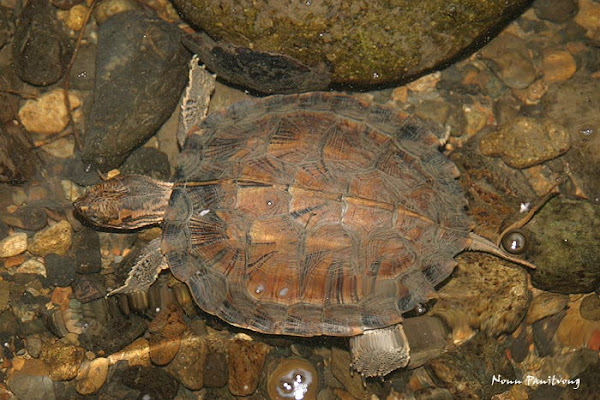Cyclemys atripons (Striped Leaf Turtle)
The common name of this Freshwater-Turtle in English is commonly called Western Black-bridged Leaf Turtle, Striped Leaf Turtle, Cardamon Leaf Turtle and Thai name called เต่าห้วยเขาบรรทัด (Dtao Huay Kao Ban-tat).

Source: siamensis.org; Cyclemys atripons Iverson & Mccord, 1997 from Thailand. Photo by Nonn Panitvong.
เต่าห้วยเขาบรรทัด : Cyclemys atripons Iverson & Mccord, 1997
Cyclemys atripons is a species of the Southeast Asian Leaf Turtle Genus (Cyclemys) within the Freshwater Pond Turtle Family (Geoemydidae), Superfamily Testudinoidea, in the Suborder Cryptodira, in the Turtles Order (Testudines), in the Reptile Class (Reptilia), in the Chordate Phylum (Chordata) in the Animal Kingdom (Animalia).
Published in Iverson,J.B. & Mccord,W.P. A new species of Cyclemys (Testudines: Bataguridae). Proc. Biol. Soc. Washington 110 (4): 629-639. (1997).
The specific epithet 'atripons' From Latin “atri” = black and “pons” = bridge, in reference to the darkly pigmented bridge.
Geographic Range
The range of Cyclemys atripons is limited to the hills of southeastern Thailand and the Cardamon Mountains region of southwestern Cambodia (Bonin et al. 2006). It possibly occurs in southern Viet Nam.
Habitat and Ecology
This semi-aquatic species inhabits calm watercourses in evergreen forested hills up to 1,000 m elevation (Bonin et al. 2006). In Cambodia, Cyclemys atripons has been recorded in seasonally inundated coastal forests, slow-moving rivers, ponds and lakes, and hill streams in evergreen forest.
Age at sexual maturity estimated at 11 years, and adult life is approximately 25 years (e.g., Cyclemys dentata is known to have lived 15 years in captivity as an adult).
Therefore generation time is estimated to be between 20 and 25 years (using age of maturity + 0.5*(length of reproductive period in life cycle) and the upper estimate is used here).
Type locality: Kao Kuap, Trat (SE Thailand)
It is consumed locally (van Dijk et al. 1999) and is traded as food and pets (Bonin et al. 2006). Documented trade numbers of Cyclemys atripons increased in China in the 1990s and 2000s, although visible trade remained low in Cambodia and Thailand.
Diagnosis
Diagnosis. Adult: Shell ovoid to heart-shaped; in aged adults elongated. Femoral mid-seam shorter than or equal to anal mid-seam; anal notch small to wide and acute-angled to obtuse-angled.
Plastron mainly or entirely yellow; if a radiat- ing dark plastral pattern is present, it consists of few thin black lines on each scute.
A similar radiating pattern may occur on the light brown carapace. Bridge in some aged adults solid black.
Top of the head with small dark specks; temporal region and neck with wide yellow to salmon stripes; underside of the neck with wide yellow to salmon stripes or unpatterned light coloured; throat unpatterned light coloured.
Morphological distinction from C. pulchristriata is difficult. Hatchling (Fig. 9): Plastron mainly yellow, with few large black spots; ocellate pattern at submarginal seams; light head and neck stripes wide, throat light coloured.
Hatchlings of C. atripons and C. pulchristriata are very similar and cannot be reliably distinguished. For maximum size and comparison with diagnostic characters of other species, see Table 3 in Fritz et al. 2008: 10.
Synonym
- Cyclemys atripons John B. Iverson & William Patrick McCord (1997)
- Cyclemys atripons Edgar Lehr & Rohan Holloway (2003)
- Cyclemys atripons atripons Holger Vetter & Peter Paul van Dijk (2006)
- Cyclemys atripons Uwe Fritz et al. (2009)
- Cyclemys atripons Turtle Taxonomy Working Group (TTWG) (2014)